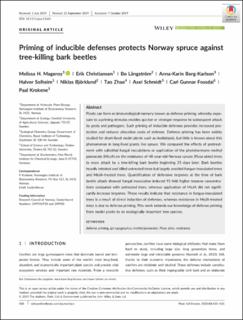| dc.contributor.author | Mageroy, Melissa | |
| dc.contributor.author | Christiansen, Erik | |
| dc.contributor.author | Långström, Bo | |
| dc.contributor.author | Borg-Karlson, Anna-Karin | |
| dc.contributor.author | Solheim, Halvor | |
| dc.contributor.author | Björklund, Niklas | |
| dc.contributor.author | Zhao, Tao | |
| dc.contributor.author | Schmidt, Axel | |
| dc.contributor.author | Fossdal, Carl Gunnar | |
| dc.contributor.author | Krokene, Paal | |
| dc.date.accessioned | 2020-10-09T07:53:14Z | |
| dc.date.available | 2020-10-09T07:53:14Z | |
| dc.date.created | 2019-11-20T09:02:29Z | |
| dc.date.issued | 2019-11-01 | |
| dc.identifier.citation | Plant, Cell and Environment. 2020, 43 (2), 420-430. | en_US |
| dc.identifier.issn | 0140-7791 | |
| dc.identifier.uri | https://hdl.handle.net/11250/2681894 | |
| dc.description.abstract | Plants can form an immunological memory known as defense priming, whereby exposure to a priming stimulus enables quicker or stronger response to subsequent attack by pests and pathogens. Such priming of inducible defenses provides increased protection and reduces allocation costs of defense. Defense priming has been widely studied for short‐lived model plants such as Arabidopsis, but little is known about this phenomenon in long‐lived plants like spruce. We compared the effects of pretreatment with sublethal fungal inoculations or application of the phytohormone methyl jasmonate (MeJA) on the resistance of 48‐year‐old Norway spruce (Picea abies) trees to mass attack by a tree‐killing bark beetle beginning 35 days later. Bark beetles heavily infested and killed untreated trees but largely avoided fungus‐inoculated trees and MeJA‐treated trees. Quantification of defensive terpenes at the time of bark beetle attack showed fungal inoculation induced 91‐fold higher terpene concentrations compared with untreated trees, whereas application of MeJA did not significantly increase terpenes. These results indicate that resistance in fungus‐inoculated trees is a result of direct induction of defenses, whereas resistance in MeJA‐treated trees is due to defense priming. This work extends our knowledge of defense priming from model plants to an ecologically important tree species. | en_US |
| dc.language.iso | eng | en_US |
| dc.publisher | John Wiley & Sons Ltd | en_US |
| dc.rights | Attribution-NonCommercial-NoDerivatives 4.0 Internasjonal | * |
| dc.rights.uri | http://creativecommons.org/licenses/by-nc-nd/4.0/deed.no | * |
| dc.title | Priming of inducible defenses protects Norway spruce against tree-killing bark beetles | en_US |
| dc.type | Peer reviewed | en_US |
| dc.type | Journal article | en_US |
| dc.description.version | publishedVersion | en_US |
| dc.rights.holder | © 2019 The Authors. | en_US |
| dc.source.pagenumber | 420-430 | en_US |
| dc.source.volume | 43 | en_US |
| dc.source.journal | Plant, Cell and Environment | en_US |
| dc.source.issue | 2 | en_US |
| dc.identifier.doi | 10.1111/pce.13661 | |
| dc.identifier.cristin | 1749677 | |
| dc.relation.project | Norges forskningsråd: 249958 | en_US |
| dc.relation.project | Norges forskningsråd: 249920 | en_US |
| cristin.ispublished | true | |
| cristin.fulltext | original | |
| cristin.qualitycode | 2 | |

